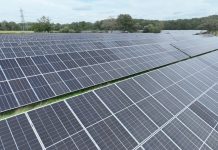Rocketing electricity bills now dropping onto doormats are spurring the fastest deployment of solar generation since the technology’s mass subsidies ended three years ago, leaders of the UK industry claim.
Britain’s generating capacity from clean photovoltaics now exceeds 15GW, nearly four times the peak output of the nation’s largest power station, Drax, according to stats released by trade lobbyists SolarEnergyUK.
Six years ago, panels on UK roofs and fields could make only 11.1 GW at peak.
New PV installations totalling 0.56GW in 2022’s first six months beat deployments for all twelve months of 2021, the lobbyists report.
Such pace puts solar on track to notch up over 1GW of new capacity in 2022 alone, expanding at speeds last seen six years ago, in the rush as the Feed-in Tariff (FiT) support closed to new registrations.
Homes and blocks of flats added 0.16GW of new capacity in 2022’s six months to June, beating the 0.15GW sparked up in all of 2021. On a quarterly basis, domestic installation has quickened almost threefold year-on-year.
Topping out factories and warehouses, a total of 0.97GW was installed between April and this month. That pace was last seen only in early 2019’s frenzy, as landlords raced to claim twenty years of FiT support, now no longer available. The amount installed during 2022’s first half, 0.19GW, is close to the 0.22GW slid and bolted onto big roofs during the whole of 2021.
Deployment on roofs reflects what installers claim is unshaken public enthusiasm for reliable, inexpensive, decarbonising solar power, while also being driven by concerns over energy bills.
Ground-mounted PV advances even faster. Solar farms gained 0.14GW of capacity in the three months to July 2022, almost triple the same quarter last year. Grid connections totalling 0.2GW so far in 2022 indicate this year will set new records.
Deuce! Advantage solar called
For the first time, supply chain chokepoints have pushed costs of panel sourcing and installation higher, outpacing even the technology’s growing efficiencies. Even so, solar’s investment attraction remains undimmed.
For home and warehouse roofs, buyers’ costs of sourcing and installing kit is outpacing inflation. Unit prices per kilowatt installed have risen by as much as 15% in twelve months, up from about £1,510 per kilowatt installed for a home-scale project smaller than 5kWp, and reaching around £1,684 per kWp installed this year.
But industry insiders say sourcing costs alone make a misleading benchmark. As the cost of power purchased from the grid has increased by 50% since last year, solar’s relative advantage has only increased.
“Rooftop solar power is as good an investment as it has ever been”, Chris Hewett, Solar Energy UK’ chief executive asserted.
“The broader crisis in fossil-fuelled energy means that this is true even though rooftop solar’s ten-year price decline appears to have halted”.
“Overall, our assessment remains positive: Solar Energy UK’s Lighting the Way forecast showed the UK could – and needs – to deploy 15GW of rooftop solar by 2030 – and we are heading in the right direction,” Hewett said. [3]
“In a time of economic crisis, this is cheap, clean, home-grown energy, providing lower bills, secure jobs and getting Britain off the hook of Russian gas,” he added.
Dr Finlay Colville, head of market intelligence at Solar Media, crunched the industry’s latest numbers.
Coville commented: “(Solar’s) outlook is extremely positive, with pipelines growing each quarter, coupled with the 2GW of utility-scale sites recently successful in the CfD Round 4 auction. New solar deployment in the UK during 2022 is set to comfortably exceed the 1GW level for the first time since 2016 when government incentives were in place”.




